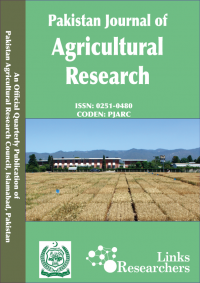Naheed Akhtar, Azra Nasim*, Ata ul Mohsin**, Muhammad Ashfaque, Shaheena Yasmin, Ghulam Jilani, Afzala Tashfeen, Waseem Ahmed Gilani, Irshad Begum* and Muhammad Munir***
ABSTRACT
Susceptibility of 20 wheat lines/varieties was studied against wheat aphid Rhopalosiphum padi L. In seedling bulk tests, the germplasm under study was grouped into three categories i.e., resistant, moderately resistant and susceptible. Data from seedling bulk tests showed that five wheat lines namely V- 01078, V-00055, KT-7, V-01180 and DN-47 were resistant with damage rating of 2- 3. Twelve wheat lines/varieties, 99B4012, 99B2278, V-9021, V-002493, Wafaq 2001, PR-84, TW0135, CT-00062, 7-03, PR-86, V-02192 and Chakwal 97 were found moderately resistant. Three wheat lines/varieties namely RWM-9313, V-00125 and Diamond were moderately susceptible (MS) with damage rating of 6. No wheat line was found as susceptible during these studies. Results of antixenosis tests (after 24 hours) showed that out of 20 only three lines i.e., V-01180, DN-47 and PR-84 were least preferred. Fifteen wheat lines/varieties were moderately preferred and only one germplasm line, V-9021 was highly preferred by this aphid. Observations after 48h showed that only two wheat germplasm lines, PR-84 and V-01180 were least preferred. Seventeen wheat lines/varieties were moderately preferred. There was only one germplasm line, namely V-9021 that was highly preferred. Combined results of antixenosis test, indicated that three wheat lines V-01180, PR 84 and DN-47 were least preferred. Sixteen wheat lines/varieties were moderately preferred. Only one wheat germplasm line, V-9021, was highly preferred. Three least preferred wheat lines i.e., V-01180, PR-84 and DN-47 were recommended to be incorporated in future breeding programmes for better crop yield.
To share on other social networks, click on any share button. What are these?






